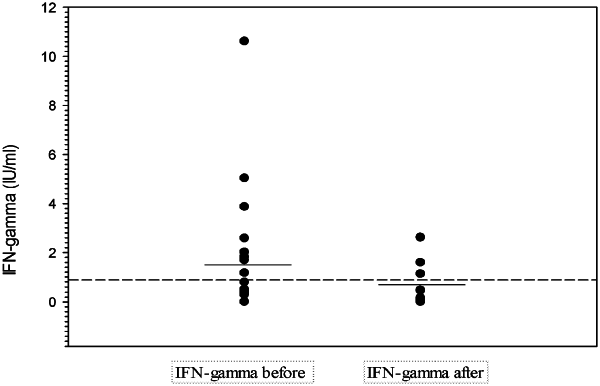| CPC G01N 33/569 (2013.01) [C07K 14/20 (2013.01); G01N 2333/20 (2013.01); G01N 2800/52 (2013.01); Y02A 50/30 (2018.01)] | 41 Claims |

|
1. A method for detecting Lyme disease in a subject, or for monitoring efficacy of a treatment for Lyme disease in a subject, comprising:
(A) contacting in vitro (i) a first biological sample obtained at a first timepoint a subject known to have or suspected of being at risk for having Lyme disease, wherein the biological sample comprises T-cells and antigen-presenting cells, and (ii) a peptide composition for diagnosis or prognosis of Lyme disease, to obtain a first test incubation mixture;
(B) incubating the first test incubation mixture under conditions and for a time sufficient for specific recognition by said T-cells of a Borrelia T-cell epitope that is present in said peptide composition to stimulate generation of a T-cell immune response indicator; and
(C) detecting a first level of the T-cell immune response indicator in the first test incubation mixture,
wherein presence of a Borrelia infection in the subject is indicated by detection in (C) of said first level of the T-cell immune response indicator that is increased relative to a first control level of the T-cell immune response indicator obtained by incubating the first biological sample in a first control incubation without the peptide composition for diagnosis or prognosis of Lyme disease, and
wherein the peptide composition for diagnosis or prognosis of Lyme disease comprises:
(a) 1, 2, 3, 4, or 5 isolated FlaB peptides that are each not more than 50 amino acids in length and that each comprise a Borrelia T-cell epitope and are selected from the FlaB peptides having the amino acid sequences set forth in SEQ ID NOS:1-5, or one or more variants thereof having at least 80% amino acid sequence identity to the amino acid sequences set forth in SEQ ID NOS:1-5;
(b) 1, 2, 3, 4, 5, 6, 7, 8, 9, 10, 11, 12, or 13 isolated DbpB peptides that each comprise a Borrelia T-cell epitope and are selected from (i) DbpB peptides of not more than 50 amino acids in length, the DbpB peptides having the amino acid sequences set forth in SEQ ID NOS:67-18, or one or more variants thereof having at least 80% amino acid sequence identity to the amino acid sequences set forth in SEQ ID NOS: 7-18, and (ii) DbpB peptides of 20, 21, 22, 23, or 24 amino acids in length, the DbpB peptides having the amino acid sequence set forth in SEQ ID NO:6, or one or more variants thereof having at least 80% amino acid sequence identity to the amino acid sequence set forth in SEQ ID NO:6;
(c) 1, 2, 3, 4, 5, 6, 7, 8, 9, 10, 11, 12, or 13 isolated p66 peptides that are each not more than 50 amino acids in length and that each comprise a Borrelia T-cell epitope and are selected from the p66 peptides having the amino acid sequences set forth in SEQ ID NOS:19-31, or one or more variants thereof having at least 80% amino acid sequence identity to the amino acid sequences set forth in SEQ ID NOS:19-31; and
(d) 1 or 2 isolated OspC peptides that each comprise a Borrelia T-cell epitope and are selected from (i) OspC peptides of 21, 22, 23, 24, 25, 26, 27, 28, 29, 30, 31, 32, 33, 34, 35, 36, 37, 38, 39, 40, 41, 42, 43, 44, 45, or 46 amino acids in length, the OspC peptides having the amino acid sequences set forth in SEQ ID NO:32, or one or more variants thereof having at least 80% amino acid sequence identity to the amino acid sequence-s set forth in SEQ ID NOS:32, and (ii) OspC peptides of not more than 50 amino acids in length, the OspC peptides having the amino acid sequence set forth in SEQ ID NO:33, or one or more variants thereof having at least 80% amino acid sequence identity to the amino acid sequence set forth in SEQ ID NO:33;
and thereby detecting Lyme disease in the subject, or monitoring efficacy of the treatment for Lyme disease in the subject.
|